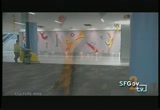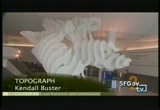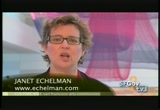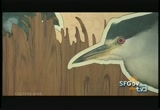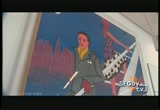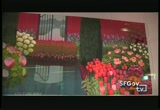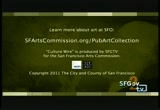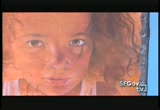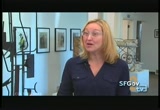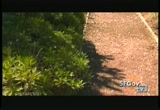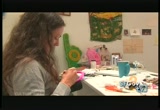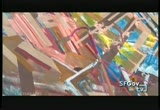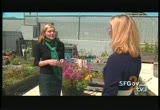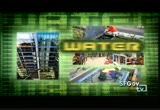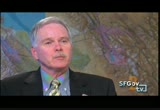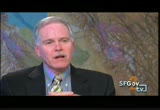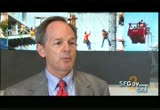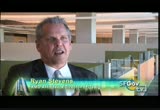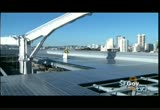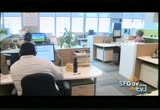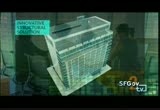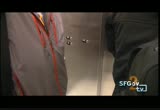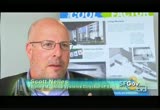tv [untitled] November 12, 2012 10:00am-10:30am PST
10:00 am
terminals and the united states. the public art program continues its 30-year legacy of integrating art into the airport environment with the addition of five new commissions that are as bold and dynamic as the new building. >> this project was completed in record time, and we were able to integrate the artist's early enough in the process that they could work with the architect said that the work that is completed is the work that really helps complement and instill the space as opposed to being tucked away in a corner. >> be experience begins with the glass facades that was designed with over 120 laminated glass panels. it captures the experience of being under or over clouds when flying in a plane. depending on the distance or
10:01 am
point of view, it can appear clear for more abstract and atmospheric. the subtle colors change gradually depending on the light and the time of day. >> i wanted to create an art work that looks over time as well as working on in the first glance. the first time you come here, you may not see a. but you may be able to see one side over the other. it features a couple of suspended sculptures. each was created out of a series of flat plains run parallel to each other and constructed of steel tubing. >> it is made up of these strata. as the light starts to shift, there is a real sense that there is a dynamism.
10:02 am
>> it gives the illusion that this cultures might be fragments of a larger, mysterious mass. >> the environmental artwork livens it with color, light, and the movement. three large woven soldiers are suspended. these are activated by custom air flow program. >> i channeled air flow into each of these forms that makes it move ever so slightly. and it is beating like a heart. if-0 when as of the forces of nature moving around us every second. >> shadow patterns reflect the shapes of the hanging sculptures. the new terminal also features a
10:03 am
children's play areas. both of the market the exploratory n.y. -- exploratorium. the offer travelers of all ages a playful oasis. using high quality plywood, they created henches shaped like a bird wings that double as musical instruments. serving as a backdrop is a mural featuring images of local birds and san francisco's famous skyline. >> in the line between that is so natural, you can see birds and be in complete wilderness. i really like that about this. you could maybe get a little snapshot of what they are expecting.
10:04 am
>> it is an interactive, keck sculpture that is interacted with by the visitor. >> they are a lot about and they fall down the belt. it moves the belt up, and if you turn that faster, the butterflies fall in the move of words. >> the art reflect the commission's commitment to acquiring the best work from the bay area and beyond. in addition to the five new commissions, 20 artworks that were already in the airport collection were reinstalled. some of which were historically cited in the terminal. it includes major sculptures by the international artists. as a collection, these art works tell the story of the vibrant arts scene in the early 1960's
10:05 am
through the mid-1980s's. the illustrate san francisco's cultural center and a place of innovation that is recognized and the love throughout the world. one of the highlights is a series of three left tapestries. they are on view after being in storage for 20 years. these tapestries representing various gardens. from his years of living in san francisco. hydrangeas, chrysanthemums, and whilst dahlias in rich, deep shades as they make their way to the baggage area. they can access behind-the- scenes information and interviews with the artist through an audio to work. it features archival audio as well as interviews with living
10:06 am
artists. he can be accessed on site by dialing the telephone numbers located near the artwork or by visiting the commission's web site. the public art speaks volumes of san francisco as a world-class city with world-class art and culture. for more information, visit >> welcome to "culturewire." today we are at recology. they are celebrate 20 years of one of the most incredibly
10:07 am
unique artist residency programs. we are here to learn more from one of the resident artists. welcome to the show, deborah. tell us how this program began 20 years ago. >> the program began 20 years ago. our founder was an environmentalist and an activist and an artist in the 1970's. she started these street sweeping campaigns in the city. she started with kids. they had an exhibition at city hall. city officials heard about her efforts and they invited her to this facility. we thought it would coincide with our efforts to get folks to recycle, it is a great educational tool. since then, we have had 95 professional artists come through. >> how has the program changed over the years? how has the program -- what can the public has an artist engage
10:08 am
with? >> for the most part, we worked with metal and wood, what you would expect from a program like ours. over the years, we tried to include artists and all types of mediums. conceptual artists, at installation, photographers, videographers. >> that has really expanded the program out. it is becoming so dynamic right now with your vision of interesting artists in gauging here. why would an artist when to come here? >> mainly, access to the materials. we also give them a lot of support. when they start, it is an empty studio. they go out to the public area and -- we call it the big store. they go out shopping, take the materials that, and get to work. it is kind of like a reprieve, so they can really focus on their body of work. >> when you are talking about
10:09 am
recology, do you have the only sculpture garden at the top? >> it is based on work that was done many years ago in new york. it is the only kind of structured, artist program. weit is beautiful. a lot of the plants you see were pulled out of the garbage, and we use our compost to transplant them. the pathway is lined with rubble from the earthquake from the freeways we tour about 5000 people a year to our facility, adults and children. we talk about recycling and conservation. they can meet the artists. >> fantastic. let's go meet some of your current artists. here we are with lauren. can you tell us how long have
10:10 am
been here so far and what you're working on? >> we started our residency on june 1, so we came into the studio then and spent most of the first couple weeks just digging around in the trash. i am continuing my body of work, kind of making these hand- embroidered objects from our day-to-day life. >> can you describe some of the things you have been making here? this is amazing. >> i think i started a lot of my work about the qualities of light is in the weight. i have been thinking a lot about things floating through the air. it is also very windy down here. there is a piece of sheet music up there that i have embroidered third. there is a pamphlet about hearing dea -- nearing death. this is a dead rabbit. this is what i am working on now. this is a greeting card that i
10:11 am
found, making it embroidered. it is for a very special friend. >> while we were looking at this, i glanced down and this is amazing, and it is on top of a book, it is ridiculous and amazing. >> i am interested in the serendipity of these still life compositions. when he got to the garbage and to see the arrangement of objects that is completely spontaneous. it is probably one of the least thought of compositions. people are getting rid of this stuff. it holds no real value to them, because they're disposing of it. >> we're here in another recology studio with abel. what attracted you to apply for this special program? >> who would not want to come to the dump? but is the first question. for me, being in a situation that you're not comfortable in has always been the best.
10:12 am
>> what materials were you immediately attracted to when you started and so what was available here? >> there are a lot of books. that is one of the thing that hits me the most. books are good for understanding, language, and art in general. also being a graphic designer, going straight to the magazines and seeing all this printed material being discarded has also been part of my work. of course, always wood or any kind of plastic form or anything like that. >> job mr. some of the pieces you have made while you have been here. -- taught me through some of the pieces you have made while you have been here. >> the first thing that attracted me to this was the printed surface. it was actually a poster. it was a silk screen watercolor, about 8 feet long. in terms of the flatwork, i work with a lot of cloddish. so being able to cut into it come at into it, removed parts, it is part of the process of
10:13 am
negotiating the final form. >> how do you jump from the two dimensional work that you create to the three-dimensional? maybe going back from the 3f to 2d. >> everything is in the process of becoming. things are never said or settled. the sculptures are being made while i am doing the collages, and vice versa. it becomes a part of something else. there's always this figuring out of where things belong or where they could parapets something else. at the end goal is to possibly see one of these collage plans be built out and create a structure that reflects back into the flat work. >> thank you so much for allowing "culturewire" to visit this amazing facility and to learn more about the artists in residence program. is there anything you like our
10:14 am
viewers to know? >> we have art exhibitions every four months, and a win by the public to come out. everybody is welcome to come out. we have food. sometimes we have gains and bands. it is great time. from june to september, we accept applications from bay area artists. we encouraged artists from all mediums to apply. we want as many artists from the bay area out here so they can have the same experience. >> how many artists to do your host here? >> 6 artist a year, and we receive about 108 applications. very competitive. >> but everyone should be encouraged to apply. thank you again for hosting us. >> thank you for including us in "culturewire." ♪ >> san francisco is home to some of the most innovative companies of the 21st century. this pioneering and forward looking spirit is alive in san
10:15 am
francisco government as well. the new headquarters of the san francisco public utilities commission at a5 25 golden gate avenue is more than just a 13-story building and office ablation. instead, city leaders, departments and project managers join forces with local architectural firms ked to build one of the greatest office buildings in america. that's more than a building. that's a living system. ♪ ♪ when san francisco first bought this land in 1999, it was home to a state office building. >> this was an old eight-story brown building the state owned and the workers' comp people were in that building. it was an old dee correctvth it building for decades. when i was a member of the
10:16 am
board of supervisors, all of us wondered why we hadn't done anything there and the mayor thought the same. >> if an earthquake happened, the building was uninhabitable. it sat there vacant for quite a while. the city decided to buy the building in 1999 for $2. we worked and looked at ways that we can utilize the building for an office building. to build an icon i can building that will house a lot of city departments. >> the san francisco public utilities commission has an important job. we provide clean, pristine public drinking water to 2.6 million people in the san francisco bay area from the hetch hetchy regional water system. with also generate clean renewable energy for city services like public buses, hospitals, schools, and much more. and finally, we collect and treat all the city's wastewater and stormwater making it safe enough to discharge into the san francisco bay and pacific ocean. >> in 2006 the puc was planning a record number of projects. >> the public utilities commission is a very infrastructure-rich
10:17 am
organization. we're out there rebuilding the water system. we've budget working on power generation in the country. we've been doing sewer for the city. we're looking at a brand-new rebuild of all watt systems in san francisco and we haven't had a home that's been other than mental. >> they staff over 900 people. the puc is in two office locations. >> you know, this is such a great place for a building. if the puc owned that building and we could make that the icon i can sustainable building puc represents, wouldn't be a dramatic idea? >> so, one of the major decisions we made was we wanted to make a statement with this building. we wanted this building to be a lead platinum building which is very few buildings in san francisco that achieved this mark. >> leadership and energy environmental design, it takes a look at the way we think about the places where we live and work. i like to think of it as
10:18 am
designed for human and environmental health. lead addresses five categories that enhances environment. indoor air quality, energy, water, materials and resources, and sustainable sites are the five categories for the lead. you can go for several gold or platinum certifications. >> the city wanted to be silver lead status. . maybe gold was a stretch. and people said, if we're going to be a sustainable organization that the pucs this has got to be the top of the line. it's got to be a lead platinum building. what does that mean to us? we run water, power, and sewer. so, those are some of the biggest things involved in lead platinum. ♪ ♪ >> by late 2008 the project, as we got the contractor on board and we were able to start pricing it, we're a multi-, multi-, multi-million dollar over budget.
10:19 am
>> the story a lot of people don't know after we got select today do this project, the first price we came in with was $180 million. and the city said, you know, this is a great building, but we just don't want to spend that much money. so, the project was on the verge of being canceled. >> if you're looking at why this building came to be, in many ways it also included mayor gavin newsome, particularly, who really had an affection for this building. he saw the design. he saw the potential. he wanted to make sure that that building got built. and he said, do what you need to do, but please, if you can make that building work, we need to have that building in civic center. >> i happened to be at a green conference santa clara. he said you shouldn't cancel that project. can you work with us? michael cohen phoned me up the next day. can we cut $40 million out of this project? it was one person more responsible than any others, it's tony irons, was the architect that was responsible
10:20 am
for the revitalization of city hall who came to my office and said, we cannot abandon this. we can't walk away from this project. we have an opportunity to really take a lot of our values and principles, particularly raising the bar as we did as a city on our green building standards, mandating the most aggressive green building standards for private construction anywhere in the united states. and showcasing them in this new building. >> the city for the sfpuc, it was critical that the building stay as a lead building. the easiest thing to do to cut out millions of dollars, let's just go from lead platinum to lead gold. but that wasn't the objective. this needed to be the best example of energy conservation of any office building in the united states. >> we became involved in the san francisco public utilities headquarter project during the time when the project was at a stand still for a number of reasons, largely due to budget issues. and at the time we were asked
10:21 am
to consider an alternative design using concrete rather than the scheme that was potentially planned for previous to that, which was a steel frame structure that used hydraulic dampers to control seismic motion. >> so, i met with my team. we worked hard. we came up with a great idea. let's take out the heavy steel structure, let's put in an innovative vertical post tension concrete structure, great idea. we did that. a lot of other things. and we came up with a price of 140 million. so, we achieved that goal. and, so, when we first started looking at the building, it was going to cost a lot of money. because of the way it was being built, we could only get 12 floors. we wanted more space for our employees. we ended up going and saying, okay, if we do a concrete building instead, which was web core's idea, we can get 13 floors, not 12 floors. the concrete doesn't require much space between the floors as a steel building does. and it could be cheaper. yes, more space, less money, great idea.
10:22 am
♪ ♪ >> we know that right now there are things happening in power, with sewer, with water that are not always proven technologies, but they're things that are enough proven you should take a bit of a risk and you should show others it can be done. >> we're showing the world, suddenly had wind turbines which they didn't have before. so, our team realizing that time would change, and realizing where the opportunities were today, we said, you know what, we started out as really something to control wind as an asset, when you combine today's technology becomes something entirely different. >> wind turbines in an urban environment is a relatively new concept. there are a few buildings in other major cities where they have installed wind turbines on the roof. and wind turbines in buildings
10:23 am
are effective. >> the discussion was do we do that or not? and the answer was, of course. if they're not perfect yet, they're building a building that will last 100 years. in 100 years someone is going to perfect wind efficient turbines. if these aren't right, we'll replace them. we have time to do that. >> the building that's two renewable energy generations. wind turbines located on the north facade. two different levels of photo volume takes. >> we have over 600 solar panels and three platforms on the building, and four integrated wind turbines. the wind turbines and the solar panels produce 7% of the building's energy. and we're reducing the use of energy here by 32% in the office building. >> the entire building is controlled by a complex computer system which monitors and adjusts air, heating and lights as well as indoor shades.
10:24 am
>> the building is going to be a smart building. it's going to have all integrated features. so, it has a monitor on the roof that knows where the sun is. as it gets warmer or colder, it heats and cools the building. as it gets lighter, shades can go up or down to make sure that you're not over using any kind of heat or air conditioning, but as it gets darker the shades can go back up. the lights inside the building self-adjust depending how close they are to the light sources outside, how light it is, how dark it is. so, you're not using energy more than you need. >> we also have occupancy sensors. if nobody is in that room, lights turn off. it's likely to have sustainable features. it's another thing to have an integrated systems sustainability. >> when you have a building that's lead platinum, there are a couple themes important. one is daylight harvesting where you harvest the daylight and have it penetrate the building so that people have views, they see sunlight, which
10:25 am
means that partitions and workstations are much lower so that people can see. >> so, human comfort combined with light reduction, the amount of electric light reduction, all with the aim of creating, you know, a marvelous workplace that people want to come to, feel comfortable working in, thrive at what they're doing, all kind of integrate together. and the daylighting lighting strategy is a very important part of that equation. >> one of the keys to this building is that we're maximizing the use of natural daylight to light the building. >> here in our south facade we have light shells. they help shade the floor, but as well light bounces off of the light shells into the interior of the floor providing more daylight into the interior of the floor. lighting is both the greatest use of energy consumption in an office building, but it also contributes to the largest
10:26 am
amount of heat gain in the building. we're maximizing the use of natural daylighting. we also have light sensors that minimize the use of artificial lighting. >> by having light outside the building skin, what that does is we are mitigating it before it hits the glass. we have a high performance, low formal gain graph. the system does not have to work as much to either cool the building or heat the building. >> this building also incorporates or utilizes under floor system for delivery of heating and cooling to the building. this in conjunction with the high efficiency equipment that we've installed in the building reduces the consumption of energy for heating and cooling by 51%. >> we have two destination elevators. destination elevator save 35 to 40% of the electrical energy over traditional elevator. these elevators save energy by
10:27 am
using a regenerative drive. when the cars are going up empty or down full of people, they generate electricity that goes back into the building grid. these elevators have energy by grouping people going to the same floor in the same cab. and the way they work is you have a shared elevator call button in the lobby. you would indicate which floor you're going to, for instance like 3, and it will direct me to elevator c. so, i'll go to an elevator with people that are going to that same floor. what's also interesting is inside the elevator floor cab there are no selection buttons because i selected my floor in the lobby. this takes some getting used to as we're all accustomed to choosing our floor inside the elevator cabs. ♪ ♪ >> another thing we saut that was a challenge for this building was the permitting process for the delivery machine to use reclaimed water in an office building. and i think that we really
10:28 am
broke the ground for future use to be much more commonplace for utilization of reclaimed water in office buildings. this building uses 60% less water than a typical osv building. that's achieved by using rainwater for landscaping, treating wastewater on-site for reuse in the building's toilets. >> the machine is an ecological waste treatment system for water resouls. so, the living machine to accelerate what happens naturally in nature is biomimickery that happens in tidal estuaries. it brings in nutrients to the microbes. it's delivered in the air, and does the rest of the process, chewing up those nutrients in the water and producing nitrogen and carbon. we're doing that in a system
10:29 am
where we're creating 12 to 16 tides per day. >> the wastewater for our building begins its journey by travel tog our primary tank which is a fairly normal looking manhole. beneath these manholes is a 10,000 gallon primary tank. there are two chambers. the trash chamber which filters out the trash and plastics and the organic solids settle out just as normal wastewater treatment process is. the water then flows to an equalization tank, a recirculation tank, and then on to tidal flow wetlands cell 1a. all those these cells look to be only 3 or 4 feet deep, they're actually 8 feet deep below this concrete sidewalk. the water repeatedly cycle into the cell from the bottom up. as the water comes up into this cell, it meets the microbes here to treat the wastewater. they flourish off the organics found in the wastewater. after mult
94 Views
IN COLLECTIONS
SFGTV2: San Francisco Government Television Television Archive
Television Archive  Television Archive News Search Service
Television Archive News Search Service 
Uploaded by TV Archive on

 Live Music Archive
Live Music Archive Librivox Free Audio
Librivox Free Audio Metropolitan Museum
Metropolitan Museum Cleveland Museum of Art
Cleveland Museum of Art Internet Arcade
Internet Arcade Console Living Room
Console Living Room Books to Borrow
Books to Borrow Open Library
Open Library TV News
TV News Understanding 9/11
Understanding 9/11